 “Tuteur” is that elegant French word for those structures designed to support and make an orderly presentation of a vining plant. Vines are by nature unruly and out of control. Their exuberant habit of growth can be as exhausting to deal with as a recalcitrant two year old. Most plant climbers I find wanting for three things-good looks, thoughtful design, and proper size. Having made a succesful foray into steel wire structures via our spheres, it seemed time to design out the poor looks and clumsy design of what was available, and fabricate some good looking tuteurs I thought would work well.
“Tuteur” is that elegant French word for those structures designed to support and make an orderly presentation of a vining plant. Vines are by nature unruly and out of control. Their exuberant habit of growth can be as exhausting to deal with as a recalcitrant two year old. Most plant climbers I find wanting for three things-good looks, thoughtful design, and proper size. Having made a succesful foray into steel wire structures via our spheres, it seemed time to design out the poor looks and clumsy design of what was available, and fabricate some good looking tuteurs I thought would work well.
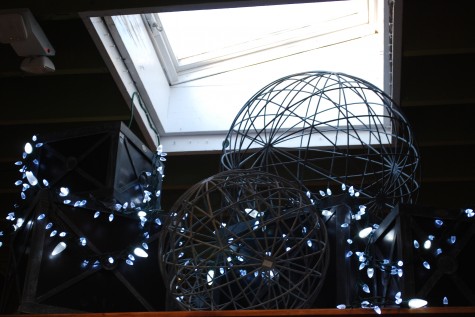 It was my intention from the beginning that a tuteur needed to be beautiful to look at once the garden had gone dormant. They might even be useful in another season. They might be designed with curves friendly to the natural shape of the vines. Those straight sided plant climbers with a curving vine bulging out of them-a bad marriage. And lastly, they need to be sized according to the eventual size of the vine they are meant to support-not to UPS shipping regulations. Some tuteurs have been designed to break down into several pieces-for economy of shipping; these never work.
It was my intention from the beginning that a tuteur needed to be beautiful to look at once the garden had gone dormant. They might even be useful in another season. They might be designed with curves friendly to the natural shape of the vines. Those straight sided plant climbers with a curving vine bulging out of them-a bad marriage. And lastly, they need to be sized according to the eventual size of the vine they are meant to support-not to UPS shipping regulations. Some tuteurs have been designed to break down into several pieces-for economy of shipping; these never work.

The sculpture of a well designed tuteur elevates a useful object to a level deserving of the word ornament-provided it is is pleasing to look at on its own. Our first round of tuteurs were finished in a clear powdercoat; this finish did not have a long life. In constant contact with leaves, water and weather, it wasn’t long before the rust took over. Though there are gardens for whom rusty steel is perfect, I was after a more serious and distinguished look.
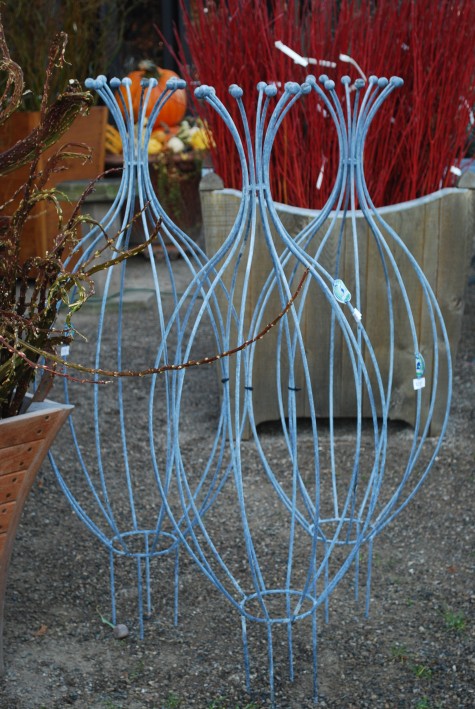 All of our tuteurs make reference to natural forms. Some say these look like onions or shallots; others are reminded of garlic cloves. In any event, we make these forms in three sizes; the size dictates the shape. Not all shapes work scaled up, or scaled down-this I learned from Rob. Sometimes the proportions have to be changed when the size changes. The ball finials at the top make the structure look finished and dressy. They also protect the gardener from a poke in the eye-has not every gardener be stabbed by their plant climbers, stakes and supports at one time or another?
All of our tuteurs make reference to natural forms. Some say these look like onions or shallots; others are reminded of garlic cloves. In any event, we make these forms in three sizes; the size dictates the shape. Not all shapes work scaled up, or scaled down-this I learned from Rob. Sometimes the proportions have to be changed when the size changes. The ball finials at the top make the structure look finished and dressy. They also protect the gardener from a poke in the eye-has not every gardener be stabbed by their plant climbers, stakes and supports at one time or another?
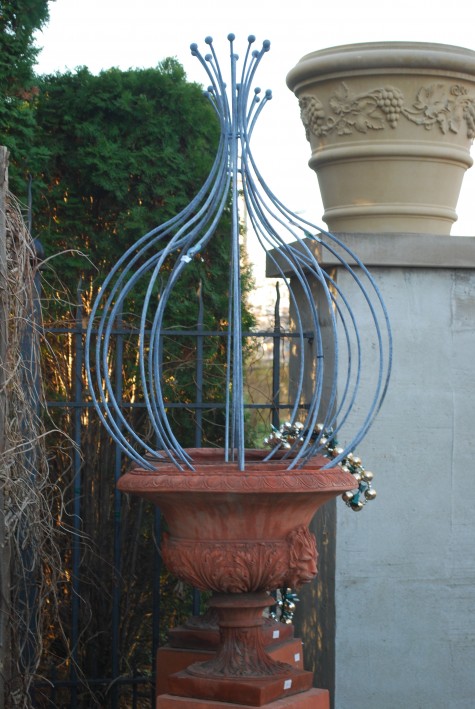 This pair of English concrete pots are all the better for their top dressing. The pots could be planted with ivy growing over one side of the tuteur in the summer-or not. They could be left out all winter empty, and look great. It is a test of a good garden pot presentation-does it represent as well empty, as it does overflowing with flowers?
This pair of English concrete pots are all the better for their top dressing. The pots could be planted with ivy growing over one side of the tuteur in the summer-or not. They could be left out all winter empty, and look great. It is a test of a good garden pot presentation-does it represent as well empty, as it does overflowing with flowers?
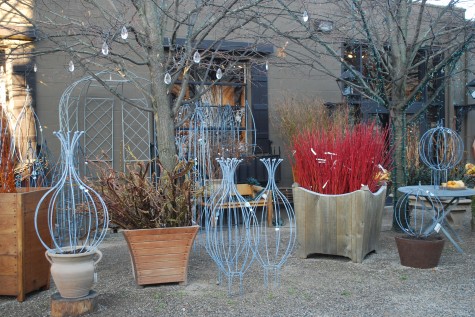 I did not anticipate how very much a part of the winter season these sculptures would prove to be. They look great with greens, berries and other materials from the garden at their base. They make something showy of our off season.
I did not anticipate how very much a part of the winter season these sculptures would prove to be. They look great with greens, berries and other materials from the garden at their base. They make something showy of our off season.

I don’t know how many times I have tried to support my plants when they grew large enough to hide my supports. This is a classic case of way too little, too late. A grown plant takes poorly to being corseted-they always have that look about them, no matter how skillfully you try to achieve a natural look. If a tuteur looks good even when it isn’t working, I have good reason to get them out well in advance.
 The shapes work in both contemporary and traditional gardens-what a relief to be able to offer a client with contemporary taste, a tuteur that looks like it belongs to them.
The shapes work in both contemporary and traditional gardens-what a relief to be able to offer a client with contemporary taste, a tuteur that looks like it belongs to them.
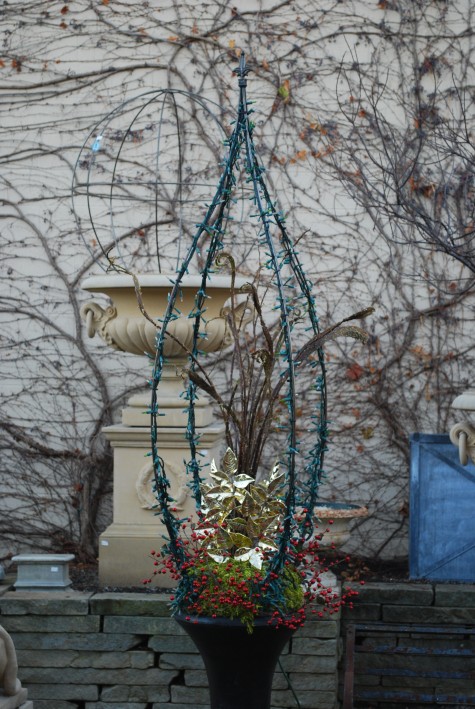 Decorating for the holidays outdoors is a form of gardening, and those strings of lights common to the season are a type of vine. Some tuteurs we design fulfills this purpose. They are very simple in shape, and overscaled such that the lit forms read as topiary at night. It will not be long before it starts getting dark at 4 in the afternoon here-any gesture defiant of the dark, I like.
Decorating for the holidays outdoors is a form of gardening, and those strings of lights common to the season are a type of vine. Some tuteurs we design fulfills this purpose. They are very simple in shape, and overscaled such that the lit forms read as topiary at night. It will not be long before it starts getting dark at 4 in the afternoon here-any gesture defiant of the dark, I like.
 This is my favorite climber, designed after Rob’s hand wrapped galvanized wire tomato cages. The tuteur is much larger at the top than the bottom. My sweet autumn clematis may have 6 stout stems coming out of the ground, but once it gets to 14 feet tall, it is billowing out in every direction; this tuteur handles that. The fern curl detail at the top is a simple reference to the look of an ostrich fern breaking dormancy in the spring; this is a form I never tire of. We make these in a range of sizes. Our individual plant stakes of this design come straight out of the ground or pot, and then gracefully curve out to catch whatever happens to be growing that way. We make them as half rounds that can be snugged up against a wall. In short, we are gardeners, designing for gardeners. In this application, they provide wire perches for a collection of holiday birds.
This is my favorite climber, designed after Rob’s hand wrapped galvanized wire tomato cages. The tuteur is much larger at the top than the bottom. My sweet autumn clematis may have 6 stout stems coming out of the ground, but once it gets to 14 feet tall, it is billowing out in every direction; this tuteur handles that. The fern curl detail at the top is a simple reference to the look of an ostrich fern breaking dormancy in the spring; this is a form I never tire of. We make these in a range of sizes. Our individual plant stakes of this design come straight out of the ground or pot, and then gracefully curve out to catch whatever happens to be growing that way. We make them as half rounds that can be snugged up against a wall. In short, we are gardeners, designing for gardeners. In this application, they provide wire perches for a collection of holiday birds.
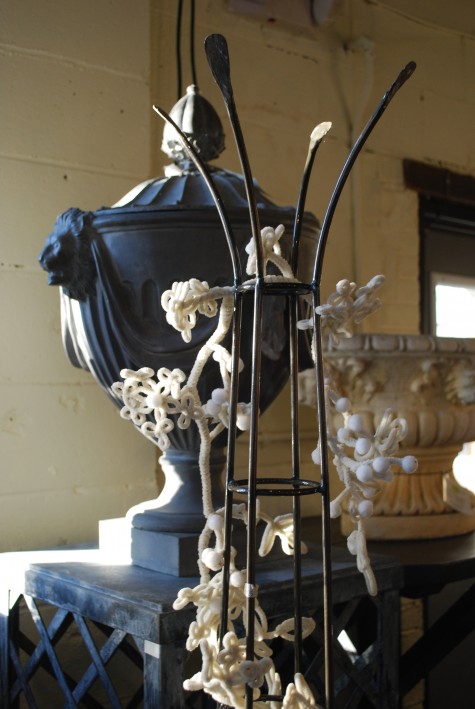
Simply functional, and simply beautiful, this is what I am after.
Hello,
I am interested in purchasing some tuteurs. DO you have a resource to share?
Dear Susan, on my website, http://www.detroitgardenworks.com, we show pictures of the tuteurs we make, and tuteurs from other manufacturers. Are you in my area? Deborah
Dear Deborah, I am still interested in purchasing a tuteur, I did call your store in April but no reply yet. What I really want is a pumpkin shaped tuteur as we have a difficult time growing pumpkins in Florida. My address is 2396 Lake Talmadge Dr. Deland FL> 32724.
Thank you.
Dear Susan, I have no idea what went awry-my staff will contact you asap. Deborah